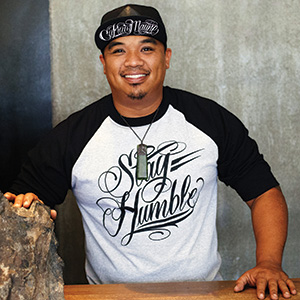

Prints and paintings hang on a stark white wall, each piece carefully illuminated by the bright beams cast from twin rails of track lighting. The spare space is nearly devoid of furniture save for two blond wood benches, which, positioned side by side in the middle of the room, offer a resting spot for anyone wanting to stay for a while and contemplate the pieces on display.
This is a gallery, but not only because prints and paintings hang here. Along a bare cement wall opposite the two-dimensional, more traditional art, racks and shelves hold T-shirts bearing limited-edition images. Cukui, in San Jose’s Japantown district, is a gallery and T-shirt shop—but here, that’s almost the same thing.
“T-shirts are a pretty basic medium,” says Cukui manager R.J. Onaka. “Everybody has T-shirts. To showcase our art and get our message across with our designs, T-shirts were a great idea for us. They’re inexpensive, but they speak volumes.”
Cukui releases new designs, in limited-edition runs of about 50 to 80 shirts, every two weeks—and once a month that release accompanies a reception for an art show. In February, professional skater Steve Caballero participated in a shirt design, in conjunction with a show featuring art inspired by Caballero’s iconic skate shoes. Cukui also collaborated on a shirt with 49ers quarterback Colin Kaepernick.
“Once people find out how we do things here, when we have releases, they’re really quick on picking up the products. Once they run out we don’t make any more. It’s always on to new things. That’s kind of the reason why we do limited stuff over here,” Onaka says.
Cukui is expanding to a second store in San Francisco, which is slated to open in August. Each location will carry limited-edition designs specific to that store.
The T-shirt as art marks a vast change from its beginnings as a workhorse garment issued by the U.S. military. In what is widely considered the first printed T-shirt, an American Air Corps gunnery unit shirt made the cover of Life magazine in July 1942, complete with a wearer bearing a large weapon.
But the history of the T-shirt goes back even further in military lore, to earlier American military adventures. The original T-shirt wearers were members of the American Navy fighting in the Spanish-American War at the end of the 19th century. The soldiers were issued T-shirts as part of their uniform, and they henceforth carried the mantle of the T-shirt as outerwear.
The T-shirt would become the go-to garment for blue-collar America. In time, it would emerge as an icon in its own right, malleable to the whims of the zeitgeist.
By the 1950s, T-shirt-cool had taken hold and spoke to the newly self-anointed American rebel spirit, with its whiff of antiheroic martyrdom and the triumph of the underdog: Marlon Brando in his white T-shirt prowling the waterfront, James Dean’s outsider-loner in denim and white cotton.
“The T-shirt has been used to convey both rebellion and conformity, depending upon the context and the type of messages,” writes Diana Crane in her book, Fashion and Its Social Agenda: Class, Gender, and Identity in Clothing.
America gave the world the T-shirt, and the world, in turn, gave Americans cheap Chinese T-shirts of the “big box” variety. Crane notes that Americans purchase about a billion T-shirts every year.
“Technical developments in the 1950s and 1960s, such as plastic inks, plastic transfers and spray paint, led to the use of colored designs and increased the possibilities of the T-shirt as a means of communication,” writes Crane.
Nothing says conformity like the social phenomenon of the big-box uniculture wardrobe, recognizable as a regional fashion trend where everyone wears the same T-shirt and khaki-shorts combo to the beach.
While itchy and ill-fitting, these shirts offered ersatz individuality in the guise of innocuous or goofy declarations, or, more to the point, with pictures of a large and intimidating pickup truck with messages about God, Guns and Freedom.
But wherever we buy them and for whatever reason we wear them, we all love our T-shirts and we all have that one we’ve kept forever. We go on vacation, we buy the shirt. There’s a family reunion, and we’re making shirts to commemorate it. “I was there: McCarthy Family Picnic, 1995.”
We wear some T-shirts until they’re practically falling apart; others occupy nostalgia space in our bureaus until such time as a garage sale is declared or a rag is needed to wash the car.
We may outgrow the T-shirt, but not the message. Or we may outgrow the message and sell the shirt on eBay for $60 to some crazed Uriah Heep fan in Antwerp…


